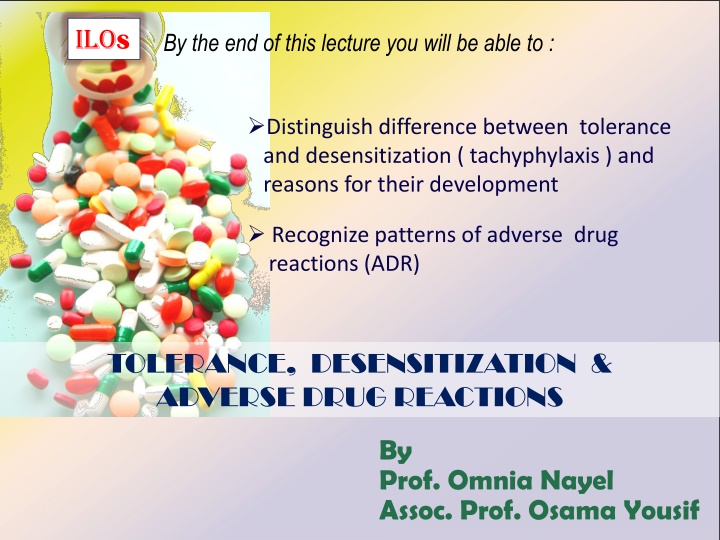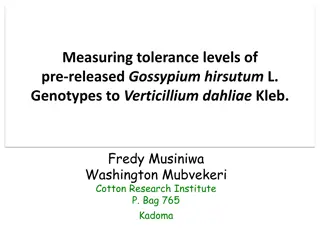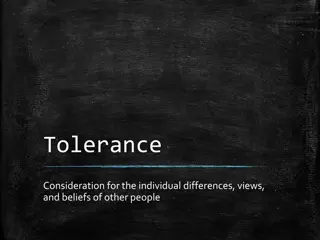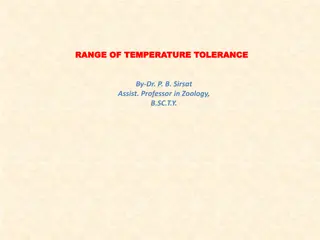
Tolerance, Desensitization, and Adverse Drug Reactions in Pharmacology
Learn about the differences between tolerance and desensitization in drug response, reasons for their development, and patterns of adverse drug reactions. Explore how tolerance can result from factors such as pharmacokinetic variables and physiological adaptative responses, leading to loss of therapeutic efficacy. Recognize the impact of harmful or unpleasant effects occurring at therapeutic doses and the various types of adverse drug reactions. Gain insights into the complexities of drug tolerance mechanisms and how they can affect patient outcomes.
Download Presentation

Please find below an Image/Link to download the presentation.
The content on the website is provided AS IS for your information and personal use only. It may not be sold, licensed, or shared on other websites without obtaining consent from the author. If you encounter any issues during the download, it is possible that the publisher has removed the file from their server.
You are allowed to download the files provided on this website for personal or commercial use, subject to the condition that they are used lawfully. All files are the property of their respective owners.
The content on the website is provided AS IS for your information and personal use only. It may not be sold, licensed, or shared on other websites without obtaining consent from the author.
E N D
Presentation Transcript
ilos By the end of this lecture you will be able to : Distinguish difference between tolerance and desensitization ( tachyphylaxis ) and reasons for their development Recognize patterns of adverse drug reactions (ADR) TOLERANCE, DESENSITIZATION & ADVERSE DRUG REACTIONS By Prof. Omnia Nayel Assoc. Prof. Osama Yousif
Phenomenon of variation in drug response, where by there is a gradual diminution of the response to the drug when given continuously or repeatedly TOLERANCE and DESENSITIZATION
DIMINUTION OF A RESPONSE Rapid, in the course of few minutes Gradual in the course of few days to weeks TACHYPHYLAXIS / DESENSITIZATION TOLERANCE These SHOULD BE DISTINGUISHED FROM Loss of effectiveness of antimicrobial agent Resistance
REASONS FOR DEVELOPMENT OF TOLERANCE EVENTS AT RECEPTORS POST PRE RECEPTOR EVENTS drug availability at the relevant receptors due to pharmaco- kinetic variables Drug becomes: > metabolized or excreted < absorbed altered distribution to tissues RECEPTOR EVENTS Nullification of drug response by a physiological adaptative homeostatic response Antihypertensive effects of ACE Is become nullified by activation of renin angiotensin system by NSAIDs eg. Barbiturates Contraceptive pills = availability metabolism of it LOSS OF THERAPEUTIC EFFICACY Refractoriness
REASONS FOR DEVELOPMENT OF TOLERANCE REASONS FOR DEVELOPMENT OF TOLERANCE PRE RECEPTOR EVENTS POST EVENTS AT RECEPTORS RECEPTOR EVENTS EXHUSTION OF MEDIATORS DOWN REGULATION BINDING ALTERATION Phosphorylation of R by -adrenoceptors activation of AC to related ionic channel [functional defect] Depletion of mediator stores by amphetamine number of receptors. Isoprenaline activation to receptors R recycling by endocytosis [structural defect]
Harmful or seriously unpleasant effects occurring at doses intended for therapeutic effects.
Type A Type C Type E End-of-Use Augmented Continuous Occurs during chronic drug administration Osteoporosis chronic corticosteroidintake PREDICTABLE Occurs by sudden stop- page of chronic drug use due to existing adaptive changes .. Withdrawal syndrome Morphine Occurs consequent but in excess of drug primary pharmacological effect. Of quantitative nature Hemorrhage Warfarin Type D Delayed Occurs after long period of time even after drug stoppage -TERATOGENICITY Retinoids - CARCINOGENICITY tobacoo smoking Type B Bizzar UNPREDICTABLE Occurs different [heterogenous / idiosyncrotic ] to known drug pharmacological effect. Usually due to patient s genetic defect or immunological response. Of qualitative nature Thrombocytopenia Quinidine
Type A Augmentation Type B Idiosyncrotic Pharmacological predictability Yes No Quantitative [ extension of pharmacology effect ] Yes (dose response relationship present) Usually Rapid Qualitative [ immune or genetic base] No (dose response relationship absent) Usually delayed Nature Dose dependent Onset of symptoms High Low Incidence and morbidity Low High Mortality Dose adjustment or Substitute by > selective + Antagonize unwanted effect of 1st drug Stop drug + Symptomatic treatment Treatment Hemorrhage Warfarin Thrombocytopenia Quinidine Example
HYPERSENSITIVITY REACTION TYPE I TYPE II Cytotoxic TYPE III TYPE IV Cell mediated Anaphylaxsis Immune complex Urticaria, rhinitis, bronchial asthma by Penicillin. Haemolytic anaemia thrombocytopenia by Quinidine Serum sickness (fever arthritis enlarged lymph nodes, urticaria) by Sulphonamides Contact dermatitis by local anesthetics creams
Quiz? The gradual diminution of response to the drug that occurs gradual in the course of few days to weeks is A) anaphylaxsis B) tolerance C) tachyphylaxsis D) idiosyncrasy
Quiz? The most important reason for development of tolerance is: A) Resistance to antimicrobial drug in organism B) Exhaustion of mediators at receptors C) Adaptive homeostatic response post receptor D) Decrease drug availability due to pre-receptor causes
Quiz? Teratogenicity to retinoids is considered A) Type C adverse drug reaction B) Type I hypersensitivity reaction C) Type C adverse drug reaction D) Type III hypersensitivity reaction
Quiz? An example of drug induced cytotoxicity is A) bronchial asthma by penicillin B) haemolytic anemia by quinidine C) serum sickness by sulphonamides D) contact dermatitis by local anaes- thetic creams






















